Santa Cruz rolled out the latest iteration of the Bronson in the early summer of 2021, along with the tag line, “if in doubt, take a Bronson out”, which certainly alludes to just how capable the brand believes the bike is.
That means everything from flat-out trail riding through to enduro racing (you only need to look at the Enduro World Series results sheet from the final round in Scotland in 2021 to see the bike was ridden to ninth place by Sam Dale and 12th by Mark Scott).
There’s still 150mm of rear-wheel travel on tap, but it’s all change when it comes to wheel size, with the Bronson now sporting a 29in wheel up front and a 27.5in wheel at the rear.
While we wanted to include the Santa Cruz Megatower for our Enduro Bike of the Year test, unfortunately the latest iteration of the bike had yet to be launched so we couldn’t get our hands on it.
Santa Cruz Bronson C R frame and suspension details

The new mixed-wheel-size Bronson frame is only available in Santa Cruz’s cheaper (and roughly 250g heavier) ‘C’ carbon as seen here, or top end ‘CC’ carbon offerings, with no mention of an alloy version just yet (and I’m not sure there will be).
Santa Cruz has continued to keep the Bronson’s rear-wheel travel to 150mm, and it’s still paired with a 160mm-travel fork up front.
Like nearly all other bikes in the range, the Bronson uses the brand’s VPP (Virtual Pivot Point) suspension system to deliver this travel. That means the rear triangle is attached to the front via two counter-rotating links, the lower of which drives the shock.
According to Santa Cruz, the latest incarnation of the Bronson has less anti-squat (how much the suspension resists bobbing while the bike is being pedalled) and less pedal kickback (the force caused when the suspension compresses, causing the pedals to ‘kick back’ when the chain is under tension).
Santa Cruz has also upped overall progression of the Bronson, which works with both air- and coil-sprung shocks.
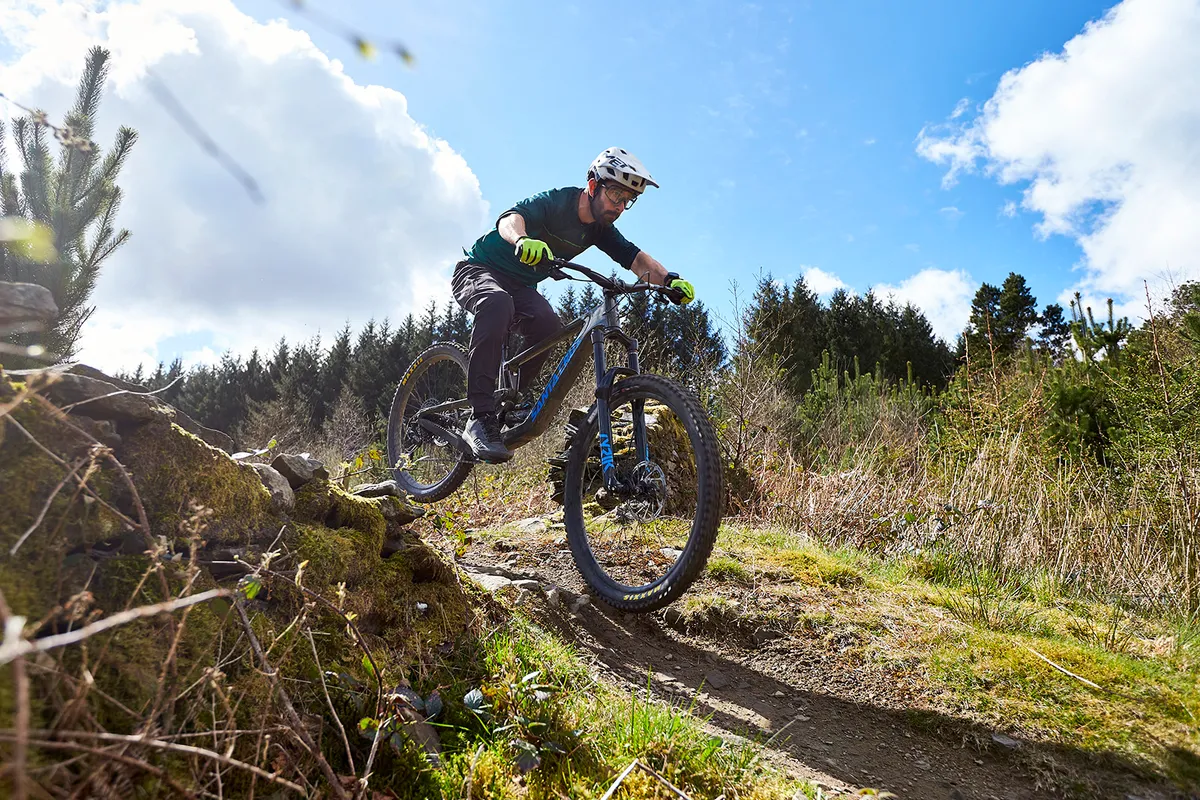
Cables are routed with internal channelling to make life easier when you need to swap or service certain parts and there’s a host of integrated rubberised frame protection. This should help ward off everything from rock strikes (on the underside of the down tube) to chain slap (along the driveside chainstay and seatstay), as well as the shuttle guard for those who like to uplift in a pickup truck.
There’s also a neat little fender that helps to protect rear-wheel spray from totally caking the shock, which is a nice touch.
Santa Cruz bikes aren’t cheap, but the lifetime frame and pivot-bearing warranty will certainly add a little peace of mind when dropping this sort of cash on a bike that’s sure to have a hard life on the trail.
Santa Cruz Bronson C R geometry
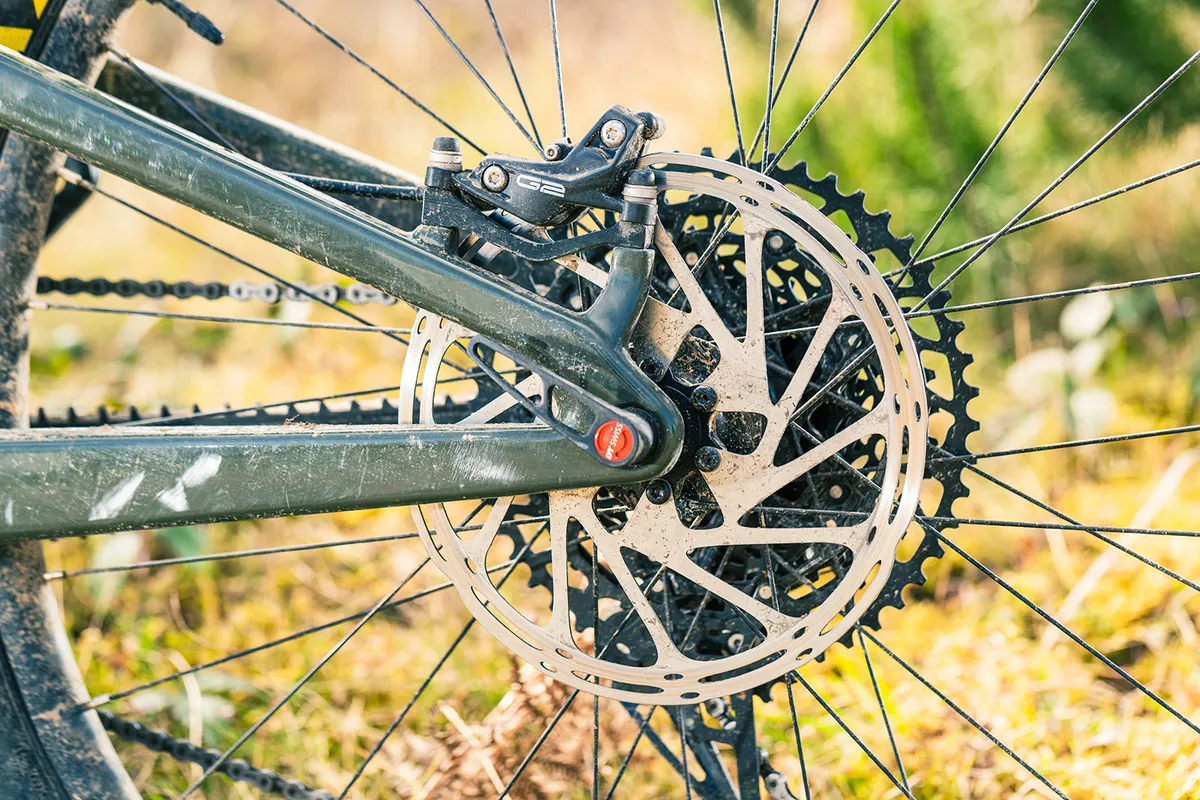
The new mixed-wheel-size Bronson comes in an impressive five sizes (XS-XL) and, thanks to the compact seat tube lengths (the medium’s is 405mm – the same as the previous model), there’s scope to even jump up (or down) a size if you’re looking for more stability at speed.
It’s worth bearing in mind that Santa Cruz has increased the Bronson’s stack height, though, with my medium test bike sporting a stack of 628mm on the latest bike versus 602mm on the outgoing model.
The head angle (in the low setting) is now slacker by just over one degree. I measured my test bike’s head angle to be 64 degrees.
In a bid to improve the seated position, the seat angle has been steepened quite a bit, from a claimed 75.3 degrees on the older bike to 77 degrees (measured at my preferred pedalling height).
Reach measurements have grown too. In the low setting, I measured a reach of 453mm, which is a decent jump from the 436mm reach on the older medium frame.
Just as Santa Cruz did with the 5010, Megatower and Nomad, the Bronson now gets a size-specific rear centre (or effective chainstay length) per frame size. That means as the frame size increases, so does the length of the rear centre.
The medium sports a rear centre of 436mm, while the extra-large has a rear centre of 443mm. This is in a bid to keep riders more central between the wheels, no matter their size.
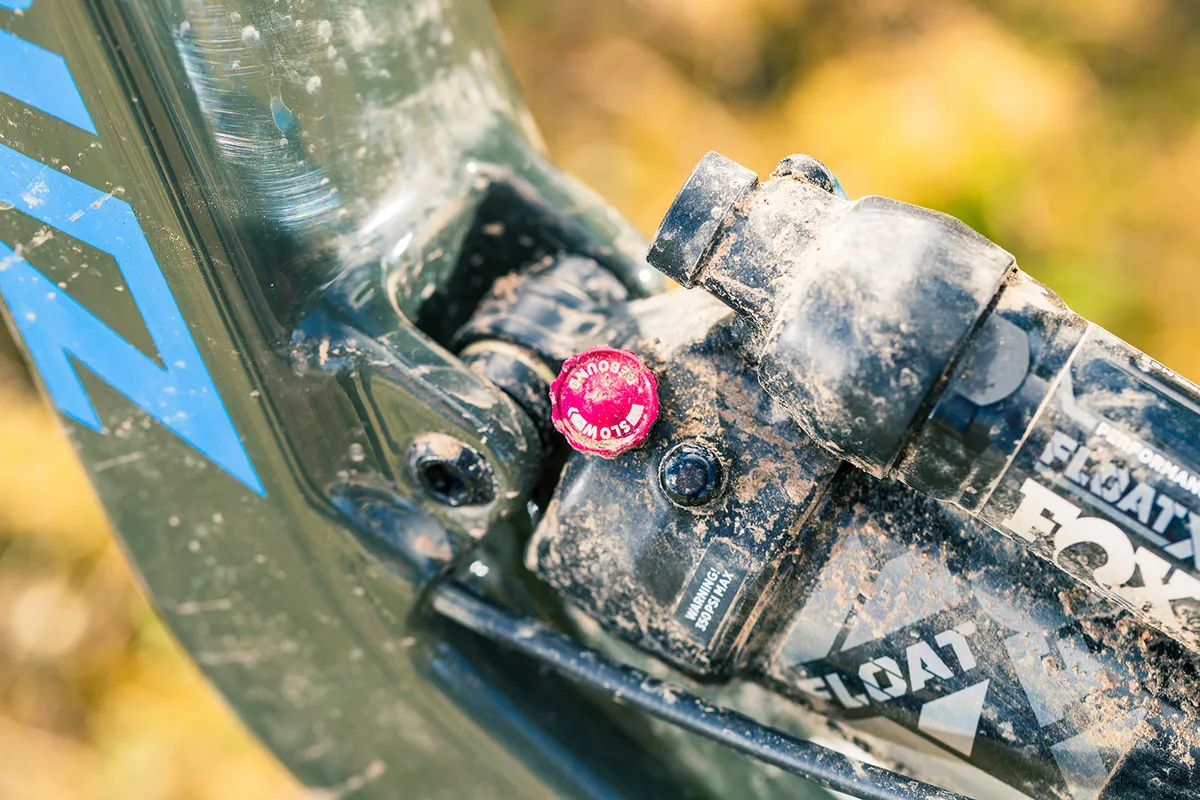
Similar to other bikes in the Santa Cruz line-up, the Bronson gets some geometry adjustment, which comes courtesy of the flip chip in the rear shock mount.
The adjustment equates to a 0.2-degree change at the head angle (which is 64 degrees in the low setting) and a 3mm shift in bottom bracket height (which is 341mm in low).
It also alters the seat tube angle by 0.3 to 0.7 degrees, depending on frame size.
Switching between settings could be a little fiddly in the past, but the new flip chip has a set of wings, which makes lifting it out and rotating it far simpler and much quicker.
Another thing to note is that this iteration of the Bronson gets more bottom bracket drop and a lower bottom bracket height. In the low setting, there’s 32mm of drop (compared to 10mm on the last bike), sitting the bottom bracket 340mm off the floor.
| | XS | S | M | L | XL | ||||||||||
|---|---|---|---|---|---|---|---|---|---|---|---|---|---|---|---|
| High | Low | High | Low | High | Low | High | Low | High | Low | ||||||
| Seat angle (degrees) | 77.6 | 76.9 | 77.2 | 76.7 | 77.1 | 76.6 | 76.9 | 76.5 | 76.7 | 76.4 | |||||
| Head angle (degrees) | 64.7 | 64.5 | 64.7 | 64.5 | 64.7 | 64.5 | 64.7 | 64.5 | 64.7 | 64.5 | |||||
| Chainstay (mm) | 427 | 432 | 431 | 432 | 435 | 436 | 438 | 439 | 442 | 443 | |||||
| Seat tube (mm) | 370 | 370 | 380 | 380 | 405 | 405 | 430 | 430 | 460 | 460 | |||||
| Top tube (mm) | 536 | 542 | 570 | 575 | 599 | 604 | 623 | 627 | 653 | 657 | |||||
| Head tube (mm) | 110 | 110 | 100 | 100 | 110 | 110 | 120 | 120 | 135 | 135 | |||||
| Bottom bracket drop (mm) | 10 | 13 | 29/10 | 32/13 | 29/10 | 32/13 | 29/10 | 32/13 | 29/10 | 32/13 | |||||
| Bottom bracket height (mm) | 344 | 341 | 344 | 341 | 344 | 341 | 344 | 341 | 344 | 341 | |||||
| Wheelbase (mm) | 1,149 | 1,154 | 1,188 | 1,189 | 1,221 | 1,222 | 1,249 | 1,249 | 1,284 | 1,285 | |||||
| Standover (mm) | 701 | 689 | 709 | 706 | 731 | 727 | 729 | 726 | 728 | 725 | |||||
| Stack (mm) | 594 | 595 | 617 | 619 | 626 | 628 | 635 | 637 | 649 | 651 | |||||
| Reach (mm) | 405 | 402 | 430 | 427 | 455 | 452 | 475 | 472 | 500 | 497 | |||||
Santa Cruz Bronson C R specifications
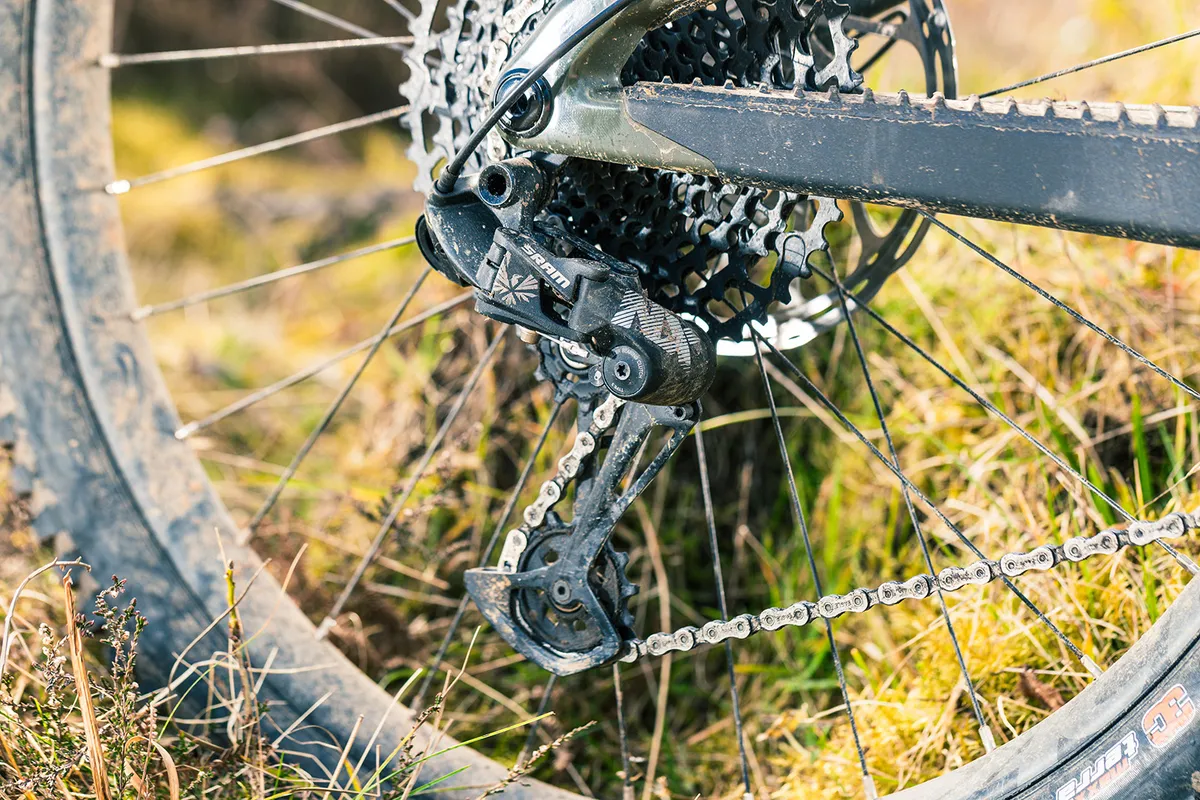
At just shy of £5,000, the Bronson C R certainly doesn’t come cheap, especially considering this is the lowest-priced model available.
It’s clear, once you’ve glanced at the spec sheet, that a lot of that cash goes into the well-finished carbon frame, because the bits bolted to it are okay but not great for the cash.
Up front, the RockShox Lyrik Select fork has 160mm of travel, which is controlled by the Charger RC damper, not the more refined Charger 2.1 found in the Select+ fork, which many bikes around this price tend to use.
Adjustment includes low-speed compression damping and rebound damping, along with spring pressure and volume (by installing or removing volume spacers).
At the rear, Fox supplies its Float X Performance shock. That means, in terms of external adjustment, you’ve got rebound damping and a low-speed compression lever to help firm things up when you’re climbing. Despite being relatively basic, it’s still a decent shock.
SRAM provides its 12-speed NX Eagle gearing. Again, considering the Bronson C R’s asking price, compared to the competition, most other bikes would be sporting GX Eagle or higher.
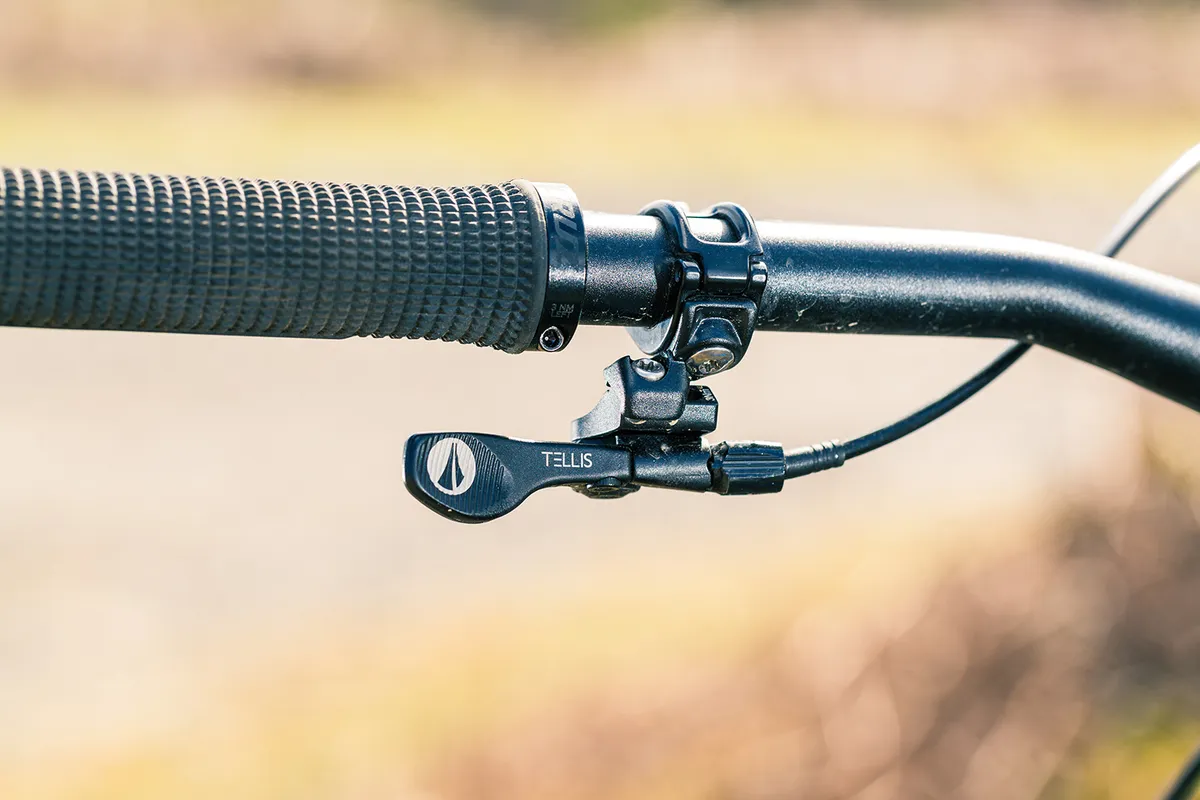
You still get a decent range thanks to the 11-50t cassette (though not as wide as GX with its 10-52t cassette), but it is quite chunky in terms of weight. The shifting isn’t quite as slick either.
Wrapping the Race Face AR rims is Maxxis rubber. Up front, the formidable and very dependable Minion DHF takes pride of place with its 3C MaxxGrip rubber compound.
Out back, a Minion DHR II uses the faster-rolling 3C MaxxTerra compound. Both tyres, however, come with EXO protection.
Considering how capable the Bronson promises to be, we’d have preferred to see at least the tougher EXO+ casing to be used at the rear.
SRAM G2 brakes use four-piston calipers to grip onto 200mm rotors.
I really like the feel of the Burgtec alloy bar, Santa Cruz House grips and Burgtec Mk3 stem, all of which are quality bits of kit.
Overall weight of the Bronson is quite low compared to others, at 15.1kg.
Santa Cruz Bronson C R ride impressions
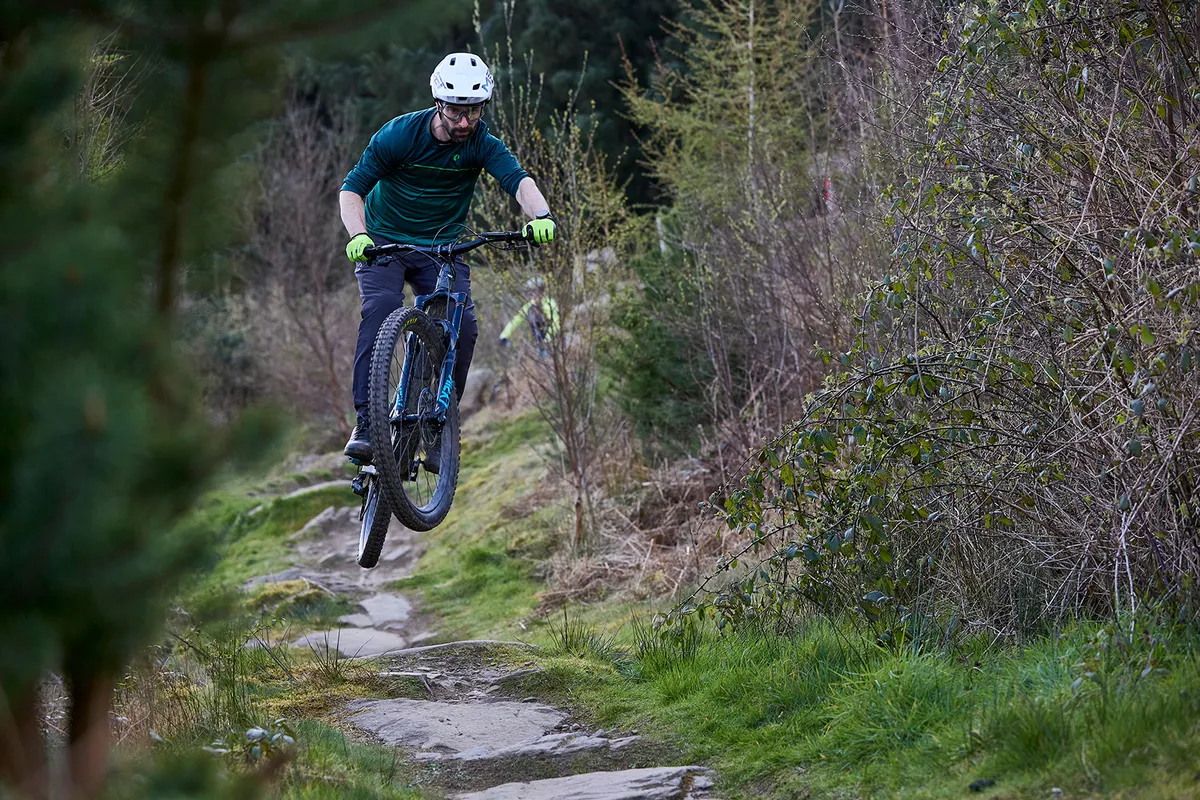
To test just how capable the Bronson is, I ensured I rode a wide variety of trails and never shied away from the climbs, no matter how technical or steep.
Trails varied from tight, technical natural affairs matted with roots and mud, to high-speed tracks at the bike park, where the rocks come thick and fast, the jumps are big and the bumps are unrelenting.
Setting up the Santa Cruz Bronson C R
Getting the suspension set up on the Bronson took a little bit of trial and error, and I had to adjust my settings after getting more familiar with how the bike behaved. Like most bikes, getting the balance right is key, and definitely worth honing on a bike such as the Bronson.
At the rear, with just over 155psi in the Float X rear shock, I was getting around 27 per cent sag (I weigh 68kg). I stuck with the single volume spacer that came as standard and had to run the rebound damping fully open in order to get the shock returning at my preferred speed.
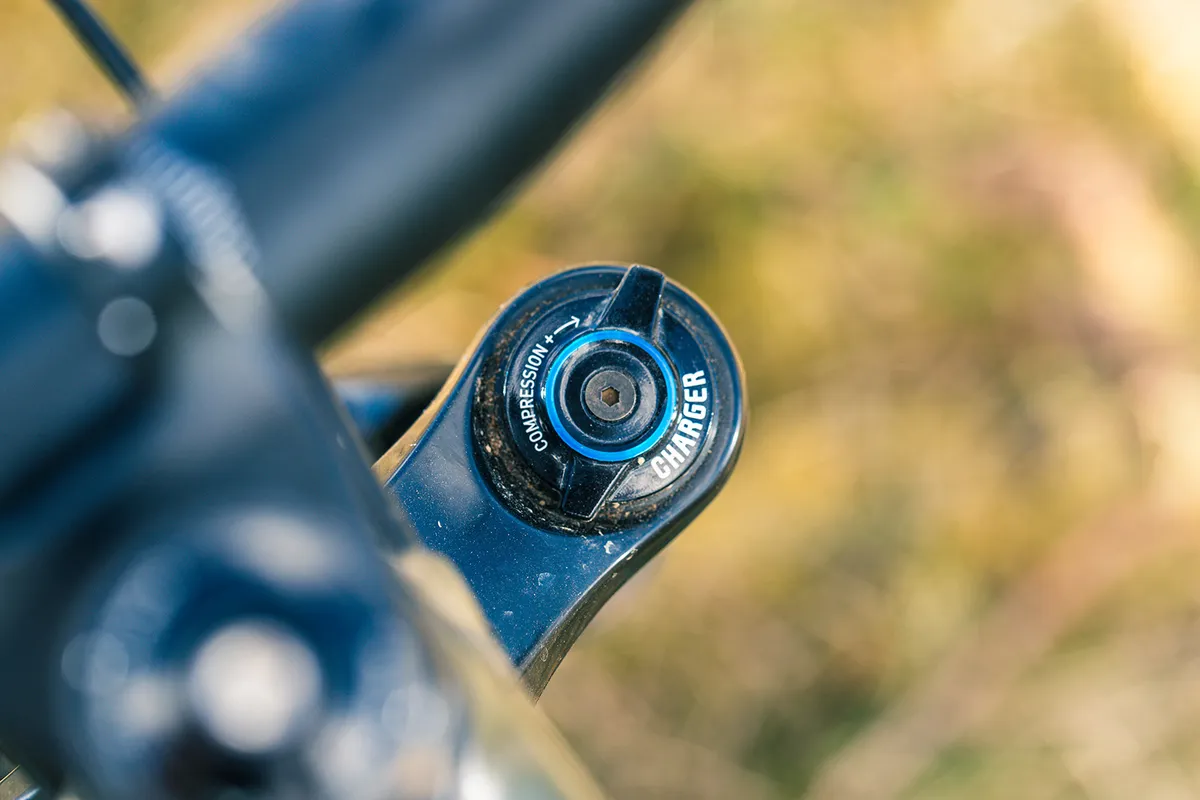
Up front, I used two volume spacers and 75psi in the air spring of the Lyrik. I left the low-speed compression fully open and had 14 clicks of rebound damping, counted from fully closed.
The only thing I really tinkered with once the suspension was set up was bar height. With an increased stack compared to the last model and more than a number of other bikes on test, I played around with the spacers above and below the stem to alter this.
In the end, I settled with 10mm of spacers beneath the stem.
Santa Cruz Bronson C R climbing performance
Under power, the Bronson picks up speed quickly and feels eager enough when pointed uphill, even with that grippy-compound tyre up front.
There’s not much in the way of suspension bob through the back end of the bike as you spin the cranks, making for a direct and efficient feel when you put the power down. This helps to make steep, punchy inclines that bit more manageable.
It was this level of efficiency and the 15.1kg weight that probably explained why I didn’t miss the larger 52t cog found on the more expensive GX Eagle gearing throughout testing.
When navigating steep, uphill turns or awkward trail obstacles, where it’s all about applying power at the right time and timing your pedalling to perfection, you’ll likely notice the somewhat lethargic pickup of the rear hub. It’s certainly no deal breaker, but again, for a bike at this price, it is a little disappointing.
The seated position feels well balanced and very comfortable, especially on longer drags. You may need to shuffle a little further forward on really steep inclines to keep the front wheel down, but these moments are few and far between.
Otherwise, there’s just no getting away from the fact that the Bronson is more than happy to climb and at no point feels a chore when pointed uphill.
Santa Cruz Bronson C R descending performance
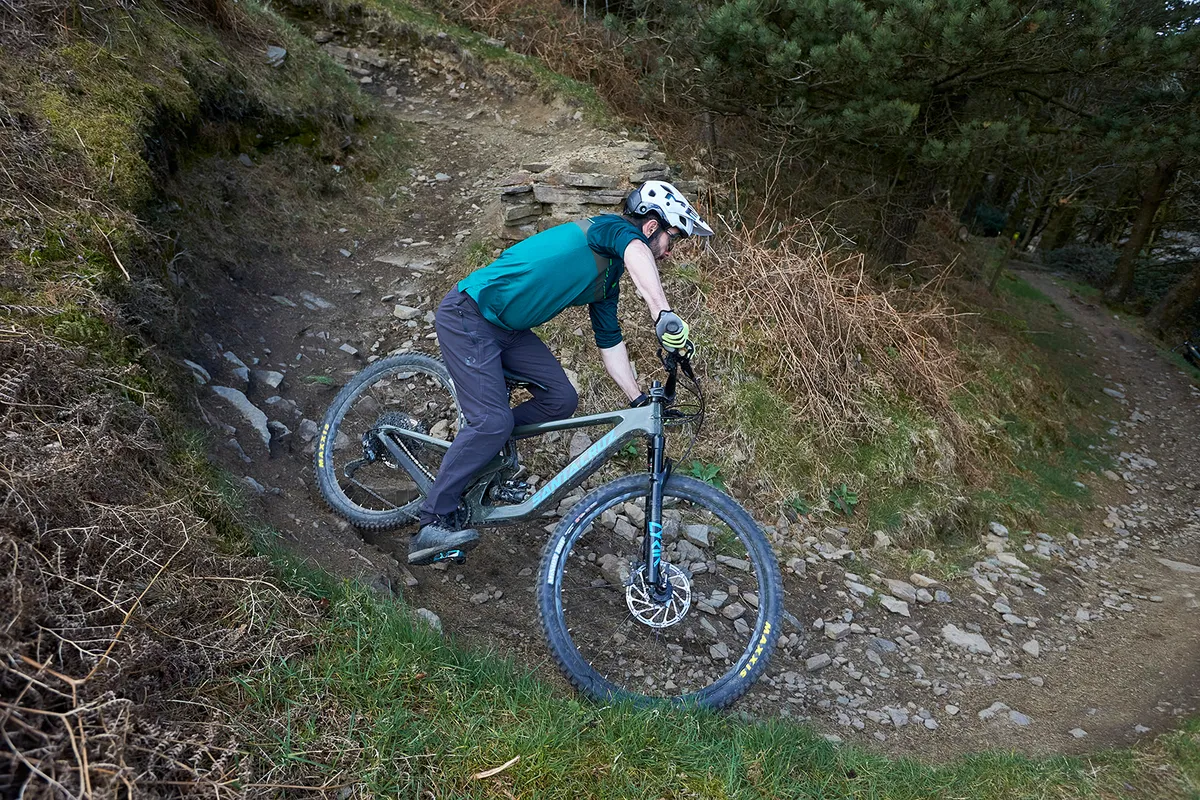
Despite its evident agility, this Santa Cruz doesn't excel at high speeds.Once the Bronson C R drops into its travel, it does a good of soaking up impacts without ever feeling it lacks support when called upon.
That means it’ll react to rider inputs when you need to weight the tyres through the turns or pump the bike over a roller to maintain speed, but still manages to maintain traction when you need it.
High-speed, repetitive hits are handled reasonably well thanks to the relatively plush mid-stroke of the Float X shock and comfortable Lyrik fork up front (though I found I had to rely more upon the air spring rather than the low-speed compression adjuster to get it sitting up in the travel where I wanted it to).
However, faster, rougher sections of track aren’t where the Bronson excels.
Sure, it’ll handle the bumps well enough and does a decent job of keeping the rider comfortable, but the bike does fidget around a little more and can be less planted than other bikes when really trucking on.

That includes the Marin Alpine Trail XR, which offers the exact same travel numbers, though is both slacker and heavier, which could help contribute to the overall stability.
A tougher rear-tyre casing would help things further and add confidence to proceedings.
It’s in these instances that the Bronson certainly feels more like a long-travel trail bike than a full-blown enduro machine. But that’s no bad thing, because we’re talking about a more well-rounded bike here, not an outright specialist.
Technical tactician

Get stuck into natural, technical terrain and it doesn’t take long to see how the Bronson helped the likes of Mark Scott and Sam Dale to their great EWS results at the final round back in 2021.
That’s down largely to the agility on offer and the confidence it encourages when picking lines.
When tackling more extreme gradients, the Bronson might not feel as surefooted as the most stretched-out enduro bikes, but the wheels track the terrain well, so the tyres keep gripping. It’s nimble and easy to manoeuvre too, which makes picking your way down a complicated, root-riddled section more manageable.
Here, the G2 brakes can feel a little under-gunned at times, and I couldn’t help but wish for the more powerful Code brakes to add a little more grunt and power to proceedings, as well as give my hands an easier time.
Should the trail mellow out, the Bronson feels lively and fun and can easily be pumped and pushed through the trail features to help maintain speed, which it manages to do really well.
It’s also keen at cornering and, as long as you’ve fettled the bar height and got the suspension balance just right (I found reducing the sag at the rear helped to avoid my hands feeling too far away from my feet), it’ll skip and slip through successive turns in an almost effortless manner.
So, while it might not be an all-out, rough and tumble big hitter compared to some, the Bronson is still a mover and shaker when it counts. Some component upgrades would make it even better, though.
How does the Santa Cruz Bronson C R compare?
The Bronson’s closest competitor in terms of travel is the Marin Alpine Trail XR. That said, the Marin (which features an alloy frame) is considerably cheaper and has an Ultimate-level fork and shock combination. The Marin might not feel as perky on the climbs, but it’s certainly more stable on high-speed descents.
Santa Cruz Bronson C R bottom line
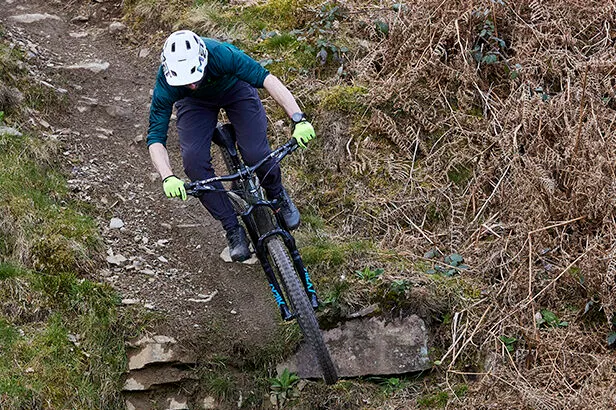
The Bronson C R is a good all-rounder that’s most at home tackling natural singletrack when pointed downhill.
It is expensive considering the parts bolted to it, though, which does take some of the shine off of it when compared to its closest rivals.
There’s agility and a keenness to be thrown about, which helps to make it a hoot to ride on nearly all trails, just don’t expect quite the same level of confidence when things get really steep, or the speeds properly pick up, when compared to more specific enduro bikes.
Yes, the Bronson is a serious amount of fun, but a few upgrades here and there could help this C R build feel even more confident when it matters most.
Enduro Bike of the Year 2022 | How we tested
Designing a high-performance enduro bike is all about balance.
While there’s no denying these bikes need to descend with the confidence and poise of a full-blown downhill bike, they still need to be pedalled back up to the top of the hill.
But, more than that, they also need to be built to last with components that can take a serious beating.
To be crowned as the best enduro bike on test, we were looking for a bike that felt pleasant enough on the climbs (no enduro bike will ever be a cross country-like mountain goat!) and easy to ride fast when pointed back downhill.
Testing the bikes required a serious amount of riding over a 12-week period. The terrain needed to be varied, too. Testing included everything from steep, natural trails covered in roots and peppered with rocks and mud, through to faster, high-speed bike park tracks with wheel-destroying rock gardens and chunky jumps.
We rode all of the bikes on test back-to-back to pin down the differences and mixed up the order in which we rode the bikes to see just how each machine felt when we were fresh – and not so fresh.
Our 2022 Enduro Bike of the Year contenders are:
- Cannondale Jekyll 2
- Canyon Torque CF8
- GT Force Carbon Pro
- Marin Alpine Trail XR
- Nukeproof Giga 297 Carbon Elite
- Propain Tyee AL 29 Performance
- Santa Cruz Bronson C R
- Whyte G-180 RS MX
Thanks to…
Thanks to our sponsors MET Helmets, Bluegrass Protection and BikePark Wales for their support in making Bike of the Year happen.
Product
| Brand | santa_cruz |
| Price | 4999.00 EUR,4999.00 GBP,5399.00 USD |
| Weight | 15.1000, KILOGRAM (M) - without pedals |
Features
| Fork | RockShox Lyrik Select, 160mm travel |
| br_stem | Burgtec Enduro Mk3, 42.5mm |
| br_chain | SRAM NX Eagle |
| br_frame | Carbon ‘C’, 150mm (5.9in) travel |
| Tyres | Maxxis Minion DHF 3C MaxxGrip EXO 29x2.5in (fr)/Maxxis Minion DHR II 3C MaxxTerra EXO 27x2.4in (r) |
| br_brakes | SRAM G2 (200mm rotors) |
| br_cranks | Truvativ Descendant |
| br_saddle | WTB Silverado Race |
| br_wheels | RaceFace AR 30 rims on SRAM 716 hub (fr) / SRAM 746 hub (r) |
| br_headset | Cane Creek 10 |
| br_shifter | SRAM NX Eagle |
| br_cassette | SRAM NX Eagle |
| br_seatpost | SDG Tellis, 150mm |
| br_gripsTape | Santa Cruz House |
| br_handlebar | Burgtec Alloy, 800mm |
| br_rearShock | Fox Performance Float X |
| br_bottomBracket | SRAM DUB |
| br_availableSizes | XS, S, M, L, XL |
| br_rearDerailleur | SRAM NX Eagle |
